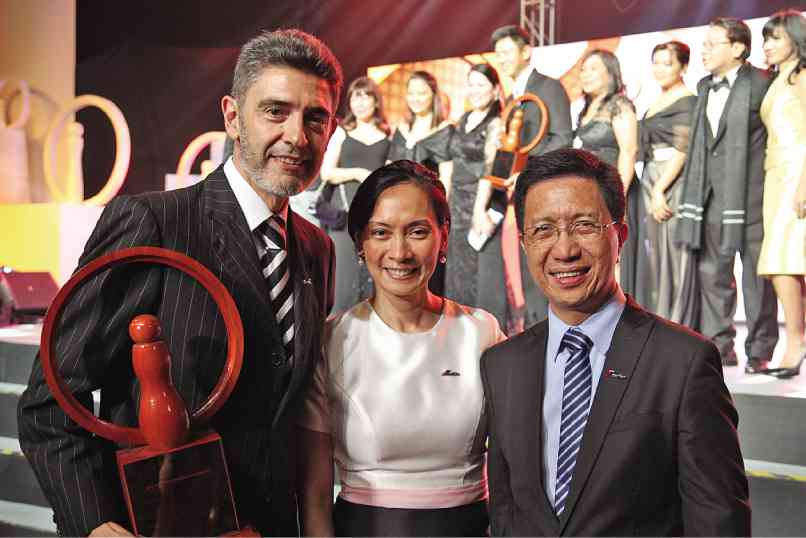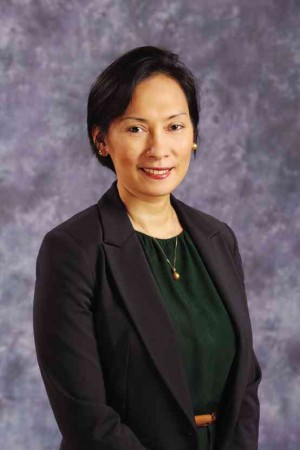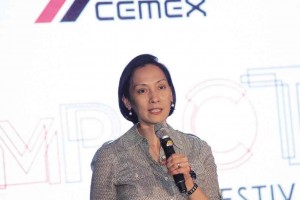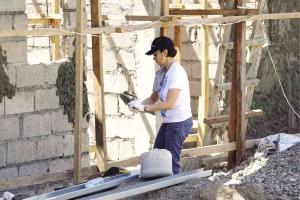Trial lawyer heeds real calling
MANILA, Philippines–She was her daddy’s girl. And all she wanted to do when she was young was to follow in the footsteps of her father—the late Mario Ongkiko, a litigation lawyer and founding partner at Ongkiko Manhit Custodio & Acorda Law Office.
Thus, when it was time for her to go to college, Ma. Virginia Ongkiko-Eala had no doubt in mind, she’d be taking up law and become a lawyer like her father.
And she did become one. She loved the practice, gave her all in every case she handled and found fulfillment in doing so. But, as fate would have it, she left the practice and made a drastic career change.
It took one high-profile case to break Gina’s heart and make her turn her back on a practice she had dreamt of and loved so much. And it took a labor strike to spur her to take that big leap into a world that was, at that time, totally unknown to her—human resources development.
She didn’t only manage to adapt to the HR role gracefully, she even excelled in this field, earning for the company the Employer of the Year Award from People Management Association of the Philippines and, for herself, the love and respect of the people in the company.
Article continues after this advertisementGina is now vice president for HR of Cemex Philippines and Asia, taking care of the needs of hundreds of people in the Philippines, and hundreds more in Cemex Malaysia, Thailand and Bangladesh.
Article continues after this advertisementWebb case
The high-profile case is that of Hubert Webb and five others, who were convicted of murder in 1995 and, eventually, acquitted by the Supreme Court about 15 years later. Then working with her father at the Ongkiko Manhit Custodio & Acorda Law Office, Gina handled the defense.
“We worked so hard on this case only to get frustrated with its outcome,” she says.
The pains inflicted on her by the outcome of this case—which made her walk away from the court scene for good—remain fresh to this day, Gina says.
“That was the most difficult day in my life, the day when we went to the court and listened to the verdict. When the verdict was out and Hubert was made to go straight to Muntinlupa, while usually those convicted were kept in city jail for a while before the transfer to allow transition, I really got disillusioned with our legal system. He didn’t even get the chance to say goodbye to his family,” she recounts.
“On my way home that day, I cried so hard and decided to call it quits and shift to corporate life,” she adds.
A former colleague at the Villaraza Law Office, where Gina started her career, paved the way for her shift to the corporate world. That colleague, who was then head of the legal department at Cemex Philippines, recruited Gina to be part of the company’s legal department.
Some people, including her father, discouraged her, saying corporate life was boring. But Gina decided to give it a try.
“That’s the only thing to watch out for in corporate life, boredom, because work can be repetitive and all. But for me, from my first day in Cemex, there never has been a dull day.”
In her first year at Cemex, Gina handled legal matters. The issues were different—contract negotiations, environmental concerns, among others—but she found them equally challenging.
Just when she was starting to adjust to a corporate setting doing something she knew so well, Gina had to make that other big leap. The key to this shift to human resources was a strike staged by the Apo plant’s stevedores at a port in Cebu. Together with a colleague from Cemex corporate affairs, Gina went to the port to talk to the workers. It was only there, while surrounded by big burly stevedores, did she realize the risk the two of them were taking. Everything went well, though, and the workers eventually ended the strike.
This bold and risky move of Gina and her colleague made the company’s CEO upset. But it also opened his eyes to Gina’s potentials. This led to her appointment first as HR head of Cemex Philippines and, shortly after, as company vice president for the Philippines and Asia. This put under her supervision the company’s operations in Thailand, Malaysia and Bangladesh.
As a regional head, she also became a member of the senior HR management team of Cemex Global.
Cemex Philippines, alone, has about 600 people working at the headquarters in Manila, Apo Cement plant in Cebu and Solid Cement plant in Antipolo. The Cemex units in Thailand, Malaysia and Bangladesh employ another 600 or so people.
Outstanding
Gina, who has been handling the HR of Cemex Philippines and Asia for 10 years now, turned out to be a natural—the job perfectly matched her personality. She even considers it her real calling.
Her colleagues at Cemex think she is “cool” and say she is “well-loved” by the people because she is “very nurturing” to the employees.
The company management is apparently equally happy to have her on board—Cemex Philippines has been strike-free for 10 years now, and the past four collective bargaining agreements were concluded in an average of 1.5 days.
A human resource team makes sure that the people and their welfare are topmost in the company’s priorities. The teams instills peace and harmony in the workplace and ensures a more inspired and efficient workforce.
Gina was instrumental in getting a people-focused item on the company’s agenda, that is “Engage our People.”
“I believe people issues are the management’s biggest stress in any company. Cash flows and all can give the management some headaches, but nothing compares to the stress arising from problems concerning people.”
Under her leadership, the HR group of Cemex Philippines underwent structural reforms and took on a more strategic role in the company. The HR department’s operations shifted from a highly centralized one to what Cemex calls accounts-based system.
Under this system, the HR people are grouped into teams, and each team is assigned an account to handle. Each account represents a unit of Cemex. Apo Cement, for instance, is one account assigned to a specific HR team. Each team is composed of HR people of different specializations—recruitment, training, health and welfare, among others. So, any team can handle by itself all possible concerns of the employees in their account.
“Before the reorganization, we were highly centralized. All employee concerns had to go to the central office,” Gina says, adding that today, only compensation is retained by the central office.
“It’s a good thing because it is proactive approach to address employee concerns as fast and as efficiently as possible. It used to take us so long to obtain even simple documents, such as a Philheath forms. Now, you get what you need right away. This system lessens the stress of the concerned employee” says Chito Maniago, the company’s corporate affairs director.
“All teams are responsible in making sure that the services we give to each account per site mirror those received in other sites,” Gina says.
Parallel to the structural changes was the introduction of an umbrella framework for all HR programs called Cemex Cares, which was centered on two key drivers: Service with a Heart and Pagmamalasakit (concern).
Under Cemex Cares are projects that foster a culture of open and free communication, promote safety and wellness and ensure employee development, welfare, compensation and community/environment involvement.
“With Cemex Cares, we want our employees to feel that certain connection with the company. We want our people to feel they are cared for by looking after their safety, development, benefits, wellness, workplace and community,” she says.
“We make sure that our programs and projects are fun, interesting and innovative enough that employees will participate not just because they are required to but because they truly enjoy them.
“We have a Monday morning mingle every first Monday of the month. We gather the people together, including the executives, in an informal setting from 9 a.m. to 10 p.m. on the lobby. We serve breakfast, hold activities and games, talk with each other, make announcements … anything that will make people interact with each other and know each other better.”
For health and wellness, the HR team had the “Walk to the Moon” program to encourage employees to walk and exercise.
“We had the employees form into groups, gave each one of them a pedometer, and count their steps every day. We say that if we walk 10,000 steps a day for three months, we will reach the moon. The group that registered the most steps won,” she says.
Because of its success, Walk to the Moon will be followed by a similar contest called “Walk Back to Earth.”
Programs like these encourage people to be more health-conscious. To date, Cemex has more than 50 serious marathoners, five triathletes who compete yearly in the Ironman, and several competitive cyclists.
For career advancement and employee development, the company has an open and accessible management style to develop budding talents. Training and leadership programs are being held regularly. These are not classroom-type of training, but more of doing things on the ground that enables employees to acquire new skills and knowledge.
“We ask the employees to identify what we call RLE, real life experience, which will be difficult assignments or new projects outside their day-to-day work. The employee and the boss will agree on a specific project and the employee will undertake the project.”
To encourage the employees’ involvement in the company’s CSR activities, the HR team implements a program called Heroes—Health, Engage and Reach Out.
“All of us have this inner desire to be of service to the less fortunate, so it wasn’t hard for us to get our employees to participate in the company’s CSR projects under the umbrella program called “Build the Nation Together.”
Keeping, letting people go
Running the HR departments of Cemex Philippines and Asia is definitely not a walk in the park for Gina, although her being a people-person, her motherly ways and legal background helped a lot.
The toughest challenge so far for her as an HR person—the true test to her vow to serve with a heart and concern—was the time when she had to retrench people, about 10 percent of the entire workforce, in line with the company’s right-sizing initiative.
“It is so hard to serve termination notice, but it is part of the job. It entails a lot of preparation, setting of the environment, knowing what to say and making sure to say the right things so the person will accept the decision,” she says.
On top of the separation package provided by the company, Gina says the HR team provided post-termination support.
“We talked to headhunters and helped our people find new jobs. We made sure they wouldn’t feel like they were just dropped by the company. We made sure no one was leaving scarred.”
These days, the biggest challenge to Gina, whether here or in the Cemex units in the three other Asian countries, is keeping the people from leaving the company.
“It is a constant challenge for us to think and come up with of out-of-the-box ways of making the people’s Cemex experience interesting and fulfilling professionally and personally,” she says.
“It is also important to make the people know and feel that we care, and we serve them not just to make a tick on our checklist. It is doing more than what the service requires of us. Employees have to feel our presence always.”
Life after Cemex
Gina is married to Dennis Valencia Eala and has three sons. Despite the demands of her job, she manages to live a balanced life.
She starts her working day, usually at 7 a.m., although regular office hours start at 9 a.m. and employees may opt for a “flexitime” of up to 10 a.m. She regularly goes to the company’s plants out of town and visits the other units in Asia.
She fulfills her motherly duties and finds time to attend to important meetings in school and to bring the boys to their football practice on Saturdays, although she confesses she really isn’t the typical football mom.
“I just bring the boys to their practice and pick them up later,” she says.
Four times a week after work, she does yoga for an hour or so which, she says, helps her cool down and relieve stress. She also does crocheting, her latest passion, which Gina rediscovered two years ago.
“We did crocheting in high school, but after that, no more. That was up until two years ago, when I discovered all those interesting materials you use in crocheting.”
Life after Cemex isn’t that clear yet for Gina. No, she is not going back to the law practice. She also doesn’t think she’ll do HR work in another company.
“I believe that, based on my personal journey as HR in Cemex, you really have to love the company, the people you work with to be able to fully embrace the HR work and to become an effective HR person. It would be strange for me to move to another company where I don’t know the people. I think this will be my first and last HR work. What’s next? I still don’t know,” she says.



